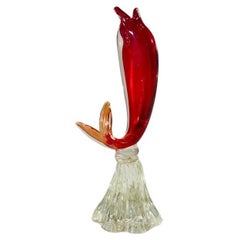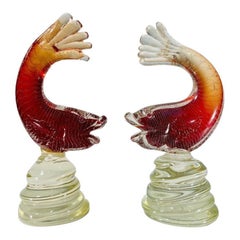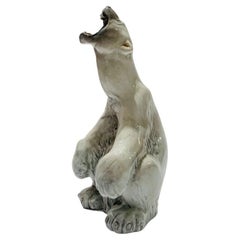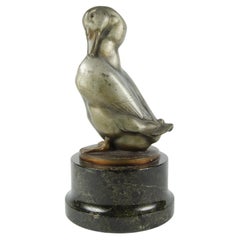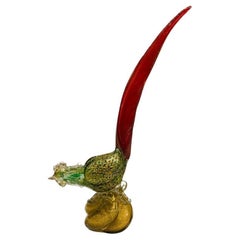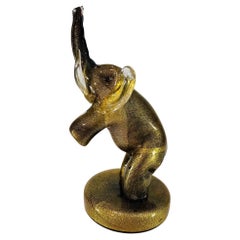South America Animal Sculptures
to
31
309
2
2
24
285
4
125
117
12
12
4
34
27
8
49
2
12
124
71
33
8
4
3
3
3
1
184
144
68
64
59
5,384
5,098
275
114
70
46
23
Height
to
Width
to
313
312
313
19
15
11
7
6
Item Ships From: South America
Seguso Vetri dArte Murano glass red fish circa 1950
By Seguso Vetri d'Arte
Located in Rio De Janeiro, RJ
Incredible Seguso Vetri dArte Murano glass red fish circa 1950.
Category
1950s Italian Mid-Century Modern Vintage South America Animal Sculptures
Materials
Murano Glass
Archimede Seguso pair of sculptures in Murano glass red fishes 1950
By Archimede Seguso
Located in Rio De Janeiro, RJ
Incredible pair of fishes in red Murano glass by Archimede Seguso with air bubbles circa 1950.
Category
1950s Italian International Style Vintage South America Animal Sculptures
Materials
Murano Glass
Royal Copenhagen Danish35 porcelain Art deco 1930 bear vase.
By Royal Copenhagen
Located in Rio De Janeiro, RJ
Incredible Royal Copenhagen Art Deco porcelain circa 1930 bear vase.
Category
1930s Danish Art Deco Vintage South America Animal Sculptures
Materials
Porcelain
Art Déco Patinated Bronze Sculpture of Duck by Gerhard Schliepstein, Germany
By Gerhard Schliepstein
Located in North Miami, FL
Early 20th century Art Déco patinated bronze sculpture of duck with marble base by Gerhard Schliepstein, Germany
By: Gerhard Schliepstein
Material: bronze, copper, tin, metal, stone...
Category
Early 20th Century German Art Deco South America Animal Sculptures
Materials
Stone, Marble, Metal, Bronze, Copper, Tin
Barbini Murano glass green, red and gold with bubbles circa 1950 large cock.
By Barbini
Located in Rio De Janeiro, RJ
Incredible BARBINI sculpture in Murano glass green, red and gold with air bubbles and applied glass circa 1950. Unique piece.
Category
1950s Italian Mid-Century Modern Vintage South America Animal Sculptures
Materials
Murano Glass
Barbini Murano glass gold circa 1950 elephant
By Barbini
Located in Rio De Janeiro, RJ
Incredible Murano glass with gold elephant attributed to BARBINI circa 1950.
Category
1950s Italian Mid-Century Modern Vintage South America Animal Sculptures
Materials
Murano Glass
19th France bronze circa 1850 "Two hares"
Located in Rio De Janeiro, RJ
Incredible france bronze circa 1850 representing "Two hares" perfect patina.
Category
19th Century French Empire Antique South America Animal Sculptures
Materials
Bronze
Barovier&Toso Murano Glass blue and pink with gold and air bubbles pheasant 1950
By Barovier&Toso
Located in Rio De Janeiro, RJ
Incredible and big Murano glass multicolor with gold and air bubbles by Barovier&Toso circa 1950, perfect. Unique piece.
Category
1950s Italian Mid-Century Modern Vintage South America Animal Sculptures
Materials
Murano Glass
Murano glass green 1950 bird.
Located in Rio De Janeiro, RJ
Incredible Murano glass bird circa 1950 green and white.
Category
1950s Italian Mid-Century Modern Vintage South America Animal Sculptures
Materials
Murano Glass
Fratelli Toso Murano glass bicolor with bubbles circa 1950 cock.
By Fratelli Toso
Located in Rio De Janeiro, RJ
Incredible Fratelli Toso Murano glass bicolor with bubbles circa 1950.
Category
1950s Italian Mid-Century Modern Vintage South America Animal Sculptures
Materials
Murano Glass
Pair of cocks in glass bicolor circa 1970
Located in Rio De Janeiro, RJ
Incredible pair of cocks in glass bicolor circa 1970.
Category
1970s Italian Mid-Century Modern Vintage South America Animal Sculptures
Materials
Art Glass
Antonio da Ros Murano glass bicolor with silver circa 1950 cock.
By Antonio da Ros
Located in Rio De Janeiro, RJ
Incredible Antonio da Ros Murano glass bicolor circa 1950 cock.
Category
1950s Italian Mid-Century Modern Vintage South America Animal Sculptures
Materials
Murano Glass
Concreto Collection, Penguin Table Sculpture (Set of 3)
By Luiz Costa e Rodrigo Irffi
Located in Santa Edwiges, MG
LÍGIA ANTUNES E ANA RESENDE [COBALTO] FOR ILUDI
The union of unconventional gazes is chemical. From the particles of experimentation, the attraction between positive poles results in...
Category
2010s Brazilian Minimalist South America Animal Sculptures
Materials
Concrete, Brass
